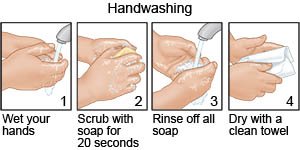Incision and Drainage
Medically reviewed by Drugs.com. Last updated on Apr 6, 2025.
Incision and drainage is a procedure to drain a pocket of fluid, such as pus or blood.
DISCHARGE INSTRUCTIONS:
Call your doctor if:
- You have red streaks or extreme pain near your wound.
- Blood soaks through your bandage.
- You have pain in your back, stomach, muscles, or joints.
- You have fever or chills.
- You feel more tired than usual.
- Fluid builds up again and creates a pocket in the same area.
- Your wound becomes red, swollen, and painful.
- You have questions or concerns about your condition or care.
Medicines:
You may need any of the following:
- NSAIDs , such as ibuprofen, help decrease swelling, pain, and fever. This medicine is available with or without a doctor's order. NSAIDs can cause stomach bleeding or kidney problems in certain people. If you take blood thinner medicine, always ask if NSAIDs are safe for you. Always read the medicine label and follow directions. Do not give these medicines to children younger than 6 months without direction from a healthcare provider.
- Prescription pain medicine may be given. Ask your healthcare provider how to take this medicine safely. Some prescription pain medicines contain acetaminophen. Do not take other medicines that contain acetaminophen without talking to your healthcare provider. Too much acetaminophen may cause liver damage. Prescription pain medicine may cause constipation. Ask your healthcare provider how to prevent or treat constipation.
- Take your medicine as directed. Contact your healthcare provider if you think your medicine is not helping or if you have side effects. Tell your provider if you are allergic to any medicine. Keep a list of the medicines, vitamins, and herbs you take. Include the amounts, and when and why you take them. Bring the list or the pill bottles to follow-up visits. Carry your medicine list with you in case of an emergency.
Drugs used to treat this and similar conditions
Ciprodex
Ciprodex (ciprofloxacin and dexamethasone) is used to treat ear infections. Includes Ciprodex side ...
Cyklokapron
Cyklokapron is used for bleeding disorder, factor ix deficiency, hemophilia a
Omvoh
Omvoh is used to treat moderate to severe ulcerative colitis or Crohn's disease in adults. This ...
Cortisporin Otic
Cortisporin Otic is used for middle ear infections, otitis externa
Zoladex
Zoladex (goserelin) is used to treat endometriosis and breast cancer in women and prostate cancer ...
Ceftazidime
Ceftazidime systemic is used for bacteremia, bladder infection, bone infection, endocarditis ...
Goserelin
Goserelin implants are used to treat the symptoms of prostate cancer. Includes goserelin side ...
Acetic acid/hydrocortisone otic
Acetic acid/hydrocortisone otic is used for otitis externa
Bacitracin/neomycin/polymyxin b ophthalmic
Bacitracin/neomycin/polymyxin b ophthalmic is used for blepharitis, blepharoconjunctivitis ...
Wound care:
Keep your wound clean and dry as directed by your healthcare provider:
- Wash your hands before and after you touch or clean your wound.

- Flush or soak your wound as directed.
- Check your wound for signs of infection, such as redness, swelling, and pain.
- Change the packing or bandages as directed. Ask for more information about what type of bandages to use.
Elevate your wound:
If your wound is on your arm or leg, keep it raised above the level of your heart as often as you can. This will help decrease swelling and pain. Prop your arm or leg on pillows or blankets to keep it elevated comfortably.
Wear a splint as directed:
You may need to wear a splint if your wound is on your hand, arm, or leg. A splint limits movement and helps your wound heal. Do not remove the splint until your healthcare provider says it is okay.
Follow up with your doctor in 1 to 3 days, or as directed:
You may need to return to have your incision cleaned and your bandages changed. Bring a list of your questions so you remember to ask them during your visits.
© Copyright Merative 2025 Information is for End User's use only and may not be sold, redistributed or otherwise used for commercial purposes.
The above information is an educational aid only. It is not intended as medical advice for individual conditions or treatments. Talk to your doctor, nurse or pharmacist before following any medical regimen to see if it is safe and effective for you.
Further information
Always consult your healthcare provider to ensure the information displayed on this page applies to your personal circumstances.
